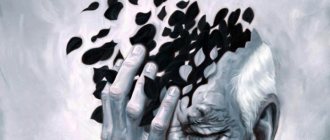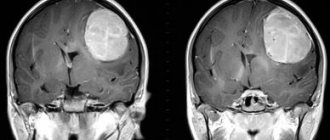Senile dementia is a neurological disease in which there is a gradual loss of cognitive abilities. This process occurs much faster than during physiological aging. Diagnosis of the disease is based on a test to determine dementia, as well as a general examination of the body.
This is a heavy burden not only for the patient himself, but also for his family. The situation is aggravated by insufficient understanding of the processes occurring with a loved one, little awareness of proper care, and the elderly person’s increasing needs for attention every day.
How to identify dementia yourself?
Only a doctor can make a diagnosis by conducting an examination and test for dementia. However, there are a few warning signs:
- Progressive memory loss. A person cannot remember recent events, forgets the names of relatives and friends, and then stops recognizing them altogether.
- Decreased ability to navigate in time and space. A person loses the ability to navigate, does not remember how to return home, get to his room or ward in the hospital, does not know the current month and year. This symptomatology is most indicative when conducting a test for dementia in older people.
- Difficulties in doing usual things. First, this concerns hobbies, then household chores, and then basic self-care processes.
- Speech disorders. A person forgets and confuses words, loses the thread of the story, speaks slowly and unclearly.
- Suspicion and aggression, most often directed, unfortunately, towards loved ones. Patients suspect their relatives of evil intentions, theft, and a desire to harm. In combination with memory impairment, this symptom becomes especially painful for loved ones, since they hear accusations that do not correspond to the real situation (a person who has just had lunch says that he is being starved).
- Mood changes. From euphoria to deep depression and apathy.
Mini-Cog
The Mini-Cog test is a simple way to detect dementia, takes only 3-5 minutes and has a high probability. The method will help assess the patient's short-term memory and visual-spatial coordination.
Here's how to test for dementia in older adults:
- The subject is told three words and asked to remember them.
- Afterwards, the person is asked to draw a watch dial in the shape of a circle, put numbers on it and indicate the given time using the arrows.
- At the end of the test, the person is asked to remember and repeat three words from the first task.
Each named word is worth 1 point. Three points indicate the absence of dementia, and zero confirms its presence in the subject. One or two points require moving on to the second test item. If it is performed without errors, then there is no dementia. In other cases, the degree of violations is assessed in accordance with the “clock test” scoring system.
Professional diagnosis of dementia
To diagnose this disease, instrumental examinations are used: computer and magnetic resonance imaging, examination of the vessels of the brain and neck (angiography). However, the most revealing test is for dementia, which is carried out by a doctor (geriatrician or neurologist) during a conversation with the patient.
Tests for dementia can be different, but they are all aimed at determining a person’s ability to think, their awareness of the environment, diagnosing memory and orientation in space. Highlight:
- SAGE test;
- yes/no questionnaire
- clock task;
- Mini-Cog technique;
- MMSE test;
- 6CIT;
- Arizona Survey (for relatives);
Diagnostics
According to WHO experts, in more than 50-60% of cases, dementia is a sign of Alzheimer's disease. In 10–20% of cases, the disease develops due to vascular damage, alcoholism, intracranial tumor or hematoma. The disease can also be a consequence of traumatic brain injury. There are several types of dementia. Only a professional can make an accurate diagnosis after examination.
Before prescribing tests, the neurologist consults with the patient and his family to check the person’s cognitive functions.
“Through questions, the doctor tries to find out whether the patient is aware of where he is, whether he remembers what date it is today, and how oriented he is in time and space. Next come biographical questions, a conversation about current events, articles and books recently read by the patient, events attended, and programs watched. This way, the doctor can assess the patient’s memory and ability to communicate,” Sonin said.
Article on the topic
Food for the brain. How to maintain mental clarity into old age? After the interview, the doctor asks the person with suspected dementia to complete a series of simple tasks. For example, repeat an action after him or remember a few words. There are several tests that doctors rely on when making a diagnosis. The most common are the Clinical Dementia Rating Scale, the Mini-Mental State Examination, and the Clock Drawing Test. You can check yourself and your loved ones online on specialized websites. It is impossible to determine the diagnosis in this way, but the test results will help you understand whether you or a relative needs specialist advice.
An oral conversation is enough for a neurologist to make a diagnosis of dementia. The doctor prescribes clinical tests only to find out the cause of the disease.
“When the doctor has determined that there are disorders and that they are severe, he can prescribe a series of diagnostic measures (laboratory and instrumental) to find out what led to the disease,” explained Sonin.
The list of necessary tests may vary depending on the individual patient, but most often doctors prescribe general blood and urine tests, examine the level of thyroid hormones in the blood serum, and also conduct biochemical studies of blood plasma and check the level of vitamin B 12 and folic acid. In addition, a neurologist can check your blood pressure to rule out hypertension and prescribe a referral for an electrocardiogram and magnetic resonance imaging (MRI).
“The tests do not in any way influence the establishment of the fact of dementia, but they can help to understand its causes. A blood test helps detect, for example, thyroid dysfunction, treatment of which can normalize the condition. An MRI will help identify, for example, a tumor in the brain, and then its removal will most likely return the person to normal life. No more dementia! - the doctor assured.
SAGE method
The SAGE test for dementia is also a questionnaire that includes logical tasks, calculation examples, and tasks to test perception and memory. Assignments require you to indicate the current date, and it is prohibited to use a calendar or other hints.
The maximum number of points a person can earn is 22, and if the subject scores from 17 to 22 points, then it is more likely that his cognitive abilities are intact. A result of 15-16 points is considered borderline and gives a signal for additional examination and observation. But a score below 14 points indicates that the subject has cognitive disorders.
Clock task
The dial test for dementia is one of the most well-known and widespread. A person needs to draw a clock face and place the hands on it in accordance with the given time. However, you cannot look at a real watch.
A relatively smooth, closed circle, the numbers located inside it in the correct order, and the correct time are considered correct. The most accurately executed drawing is scored 10 points.
It is important to take into account the person’s concomitant diseases and adjust tasks accordingly. For example, an elderly person suffering from Parkinson's disease may not be able to draw an even circle, close it, or write numbers in the required positions. In addition, an elderly patient may have poor vision and simply not see what he is writing. Therefore, the counting test is used as an alternative. The subject is asked to subtract 7 from 100 five times, while keeping the intermediate result in mind.
The Mini-Cog test for dementia in the elderly is a more complicated version of the clock task. It differs in that before performing the dial task, the patient is given three random words. A person must remember them and, after finishing working with the dial, reproduce them.
Clock test
The dementia watch test is widely known, quite simple and informative, so it can be successfully used for the early detection of dementia. The person is given a blank piece of paper and a pencil, asked to draw a clock with a round dial and numbers on it, and also use the arrows to indicate the desired time (usually fifteen minutes to two).
The patient cannot use any hints, but must complete the task absolutely independently. The dementia clock test is assessed on a ten-point scale:
- 10 points correspond to the norm: a circle is depicted, the numbers are located correctly, and the arrows point to the numbers corresponding to the given time;
- 9 points if there are slight deviations in the position of the clock hands;
- 8 - significant deviations in the location of the arrows (one arrow is mistaken by more than one digit);
- 7 – large and small arrows are positioned incorrectly;
- 6 - arrows do not indicate time at all;
- 5 - numbers in the circle are arranged in reverse order or at different distances;
- 4 – the clock is not complete, since some numbers are missing, or they are located outside the circle;
- 3 — the clock face and numbers are not interconnected;
- 2 - a person tries to do a task to pass the test, but without any success;
- 1 - the subject does not try to do the exercise.
Test 6 CIT
The Dementia Test 6 CIT includes 6 tasks and is completed in 3-5 minutes. Questions are asked about what year, month and hour it is. Then the doctor dictates a fictitious (any made up) address (in the format: first name, last name, city, street, house number), which the person must try to remember. Afterwards he is asked to count from 20 to 0 and name all the months of the year in reverse order, starting from December. And finally, he needs to dictate the memorized data. The test is scored, with the norm being from 0 to 7 points, and a higher number indicates the degree of cognitive impairment.
Thus, with the help of simple tests, you can determine the presence of dementia, and when repeating these examinations, you can talk about the progression of the disease. However, it is important to remember that only a doctor can interpret the results correctly.
How to recognize dementia in a loved one?
With different types of dementia, symptoms may vary and appear in different sequences.
Signs of dementia:
- Constantly loses important things: documents, keys, etc.;
- Puts things in completely unusual places;
- Suspects that lost items are stolen and cannot be dissuaded;
- He asks the same thing over and over again, forgetting the answer;
- Has difficulty navigating on the street;
- Makes serious mistakes in things that used to be easy (for example, filling out receipts);
A person who develops dementia often feels weak and suffers from the fact that they cannot do what they used to do easily. He can hide problems and simply refuse difficult tasks, explaining that he doesn’t want to or doesn’t have time.
There are many tests to recognize dementia and its first signs. But you need to understand that a diagnosis is never made solely on the basis of the patient’s performance of tests. The doctor evaluates many indicators, but tests are quite suitable as the “first call” that will force you to see a doctor.
Some diseases may show signs of dementia, the elimination of which may improve the patient's condition.
What diseases mimic dementia
.
- depression;
- thyroid diseases;
- lack of vitamins (for example, group B, vitamin B12);
- infections;
- brain tumor.
One of the simplest tests to determine signs of dementia is MiniCog.
- A person is asked to remember any three unrelated words. For example, an apple, a table, a dog.
- Next, they are asked to draw from memory a round clock face with all the numbers and hands that show a certain time, for example, four hours and thirty minutes.
- Give the person time to complete the task.
- After completion, ask three words that you said before. A healthy person can easily cope with this task. With the development of dementia, errors in this test often begin to appear early: for example, mirror placement of numbers, numbers 13, 14 on the dial, etc. Usually, in this situation and in everyday life, problems are already noticeable that can alarm relatives. There is no need to wait for the problems to disappear. The sooner you see a doctor, the more options for treatment.
What should you do if a loved one shows signs of dementia?
Most often, dementia in old age develops gradually, and it is difficult to say when the first warning signs appeared. Relatives often attribute the elderly person’s forgetfulness to age and delay seeking help, wasting months and years when the patient’s condition can still be improved.








